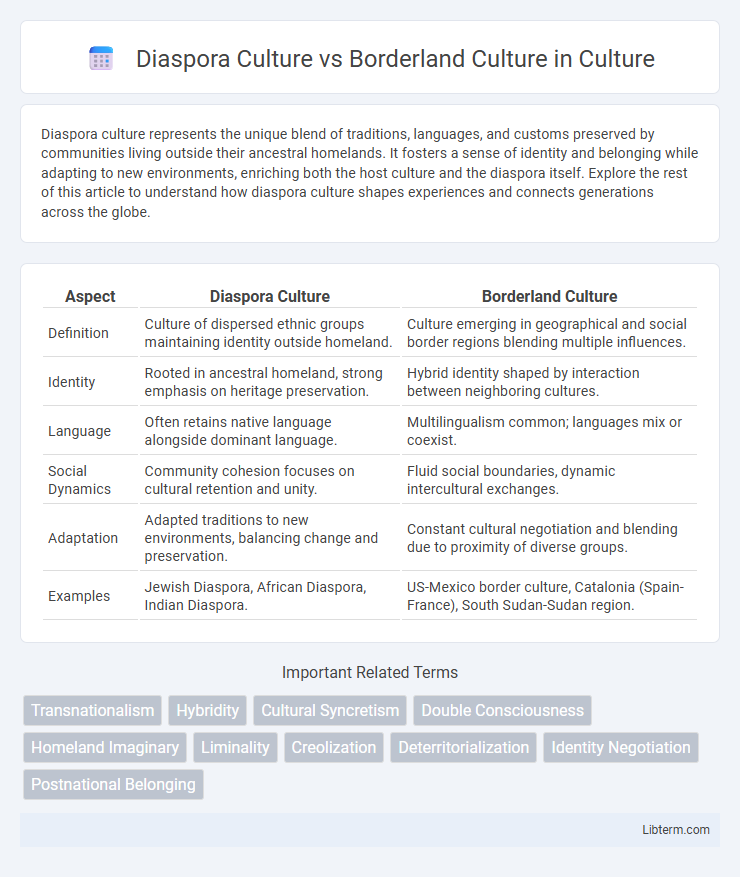Diaspora culture represents the unique blend of traditions, languages, and customs preserved by communities living outside their ancestral homelands. It fosters a sense of identity and belonging while adapting to new environments, enriching both the host culture and the diaspora itself. Explore the rest of this article to understand how diaspora culture shapes experiences and connects generations across the globe.
Table of Comparison
| Aspect | Diaspora Culture | Borderland Culture |
|---|---|---|
| Definition | Culture of dispersed ethnic groups maintaining identity outside homeland. | Culture emerging in geographical and social border regions blending multiple influences. |
| Identity | Rooted in ancestral homeland, strong emphasis on heritage preservation. | Hybrid identity shaped by interaction between neighboring cultures. |
| Language | Often retains native language alongside dominant language. | Multilingualism common; languages mix or coexist. |
| Social Dynamics | Community cohesion focuses on cultural retention and unity. | Fluid social boundaries, dynamic intercultural exchanges. |
| Adaptation | Adapted traditions to new environments, balancing change and preservation. | Constant cultural negotiation and blending due to proximity of diverse groups. |
| Examples | Jewish Diaspora, African Diaspora, Indian Diaspora. | US-Mexico border culture, Catalonia (Spain-France), South Sudan-Sudan region. |
Defining Diaspora Culture
Diaspora culture embodies the shared identity and collective memory of dispersed ethnic communities maintaining connections to their homeland amid host societies. It manifests through language preservation, transnational networks, and cultural rituals that affirm a hybrid identity transcending geographical borders. This cultural resilience fosters solidarity and adaptability within multicultural environments, distinguishing diaspora culture from borderland culture, which arises from geographical and political frontiers where multiple cultures intermingle.
Understanding Borderland Culture
Borderland culture emerges in regions where distinct national or ethnic identities intersect, resulting in a hybrid social fabric that blends traditions, languages, and customs from multiple groups. This culture is characterized by fluid identities, adaptive practices, and a dynamic negotiation between belonging and difference shaped by political, historical, and geographic factors. Understanding borderland culture requires recognizing the impact of cross-border interactions, migration, and conflict that continuously redefine community boundaries and cultural expressions.
Historical Origins and Development
Diaspora culture emerges from the displacement and resettlement of ethnic or cultural groups, often maintaining strong ties to a homeland while adapting to new environments, as seen in Jewish, African, and Armenian diasporas. Borderland culture develops in regions where distinct cultural, political, or ethnic groups intersect, fostering hybrid identities influenced by overlapping sovereignties and traditions, such as in the U.S.-Mexico border or the Catalonia-Spain borderland. The historical origins of diaspora culture are rooted in migration, exile, and forced dispersal from ancestral lands, while borderland culture arises from sustained cross-cultural interaction and negotiation within contested geographical spaces.
Identity Formation in Diaspora Communities
Diaspora culture shapes identity formation by blending homeland traditions with host society influences, creating hybrid identities that reflect both continuity and adaptation. Borderland culture emphasizes fluid identities formed through constant interactions and exchanges between neighboring cultures, fostering a sense of belonging that transcends fixed national boundaries. In diaspora communities, identity emerges from negotiating cultural preservation and transformation within borderland-like spaces of hybridity and multicultural encounters.
Hybridization in Borderland Cultures
Borderland cultures exhibit a unique hybridization process, blending elements from multiple ethnic, linguistic, and national identities due to their geographic positioning between distinct cultural zones. This hybridity contrasts with diaspora cultures, which often maintain a connection to a singular homeland identity while adapting to the host environment. In borderlands, cultural practices, languages, and social norms merge fluidly, creating dynamic, syncretic communities that challenge rigid cultural boundaries and promote continuous negotiation of identity.
Language and Communication Differences
Diaspora culture often preserves ancestral languages mixed with dominant regional languages, fostering bilingual or multilingual communication styles rooted in heritage and identity. Borderland culture exhibits fluid linguistic exchanges, incorporating dialects and code-switching due to close interactions between neighboring regions, leading to hybrid communication patterns. Differences arise as diaspora communities emphasize language as a link to origin, while borderland groups prioritize practical communication adaptability across cultural boundaries.
Cultural Adaptation and Resistance
Diaspora culture exhibits adaptive strategies rooted in preserving ancestral traditions while integrating aspects of host societies, fostering hybrid identities that navigate cultural continuity and transformation. Borderland culture embodies a dynamic resistance to dominant national narratives through the blending of multiple cultural influences, creating unique social practices that challenge rigid boundaries. Both cultures demonstrate resilience by negotiating identity in the face of displacement and socio-political pressures, emphasizing the role of language, rituals, and community networks in sustaining cultural memory.
Transnational Networks and Connections
Diaspora culture thrives on transnational networks that maintain strong emotional, economic, and political ties across global communities, fostering a shared identity despite geographical dispersion. Borderland culture emerges from the fluid interactions at national frontiers, blending distinct cultural elements through daily cross-border exchanges and hybrid social practices. These transnational connections in diaspora emphasize global solidarity and heritage preservation, while borderland networks prioritize localized adaptation and cultural negotiation.
Influence on Art, Music, and Literature
Diaspora culture profoundly shapes art, music, and literature by blending ancestral traditions with contemporary global influences, creating hybrid forms that express identity and resilience. Borderland culture fosters a unique creative expression rooted in the intersection of diverse ethnicities and languages, often highlighting themes of conflict, coexistence, and cultural negotiation. Both cultural frameworks contribute rich narratives and stylistic innovations, enriching the global artistic landscape through their distinct, place-based experiences.
Future Trends: Merging and Diverging Paths
Diaspora culture continuously shapes identity through transnational connections and digital communication, enabling dynamic cultural exchanges that transcend geography. Borderland culture, rooted in physical proximity and historical negotiations, evolves with shifting political boundaries and cross-border interactions. Future trends suggest these cultural forms may both merge via hybrid identities fostered by technology and diverge as socio-political contexts influence distinct communal narratives and practices.
Diaspora Culture Infographic

 libterm.com
libterm.com